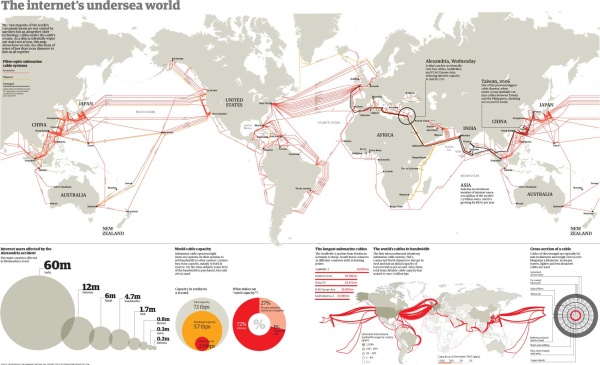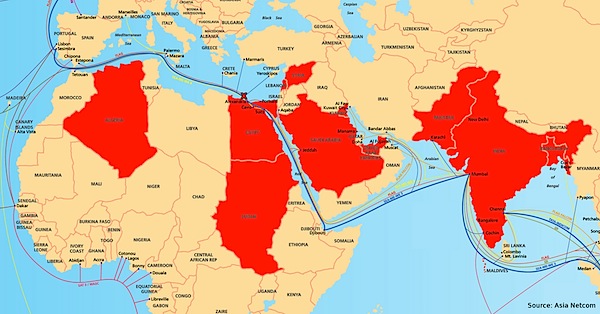The Guardian published a summary of the ongoing impact from the transcontinental fiber-optic submarine cable cuts along with a map from Telegeography.com:
According to reports, the internet blackout, which has left 75 million people with only limited access, was caused by a ship that tried to moor off the coast of Egypt in bad weather on Wednesday. Since then phone and internet traffic has been severely reduced across a huge swath of the region, slashed by as much as 70% in countries including India, Egypt and Dubai. […]
“It will depend on how bad the damage is, but they’ll find the sections in question and bring them up onto a ship for repair before sinking them again,” said Mauldin. “It could take a week or possibly two weeks.”
The fibre optic wires in question Рcalled Flag Europe-Asia and Sea-Me-We 4 Рare some of the most vital information pipelines between Europe and the east. The latter, which runs in an uninterrupted line from western Europe to Singapore, had only recently been opened after a mammoth £500m, three-year installation project. Between them, the two lines are responsible for around 75% of all connectivity in the Middle East and south Asia.
“The problems are really at pinch points where increasingly huge amounts of information are coming through,” said Jim Kinsella, chairman of Interoute, Europe’s largest fibre optic network provider. He said that improvements are scheduled for submarine cabling, but that plans to send more internet traffic over land connections rather than under the sea had been set back by political wrangling.
Renesys, a network Monitoring provider, has been posting analysis of the impact country-by-country
[…] These systems provided much of the capacity into the Middle East and the Indian subcontinent from the west. Although some countries were hurt more than others, the loss of connectivity was extensive and very widespread. Some countries and a few providers were almost completely knocked off the Internet. As Day 1 came to a close, it was clear that the damaged cables were not going to be repaired anytime soon and the impacted parties would have to look for alternatives to waiting it out.
Day 2 and 3 saw a frenzy of activity as local providers in the region tried to broker agreements with anyone who still had capacity. They were under intense pressure to restore service to local governments and businesses. In turn, global and regional providers with surviving capacity into the region were busy hunting for new customers. We definitely had a seller’s market. At Renesys, we watched all of the activity with great interest and decided to wait until the end of Day 3 to report on the winners and losers, after the initial deals were made and things had settled down to some degree.


